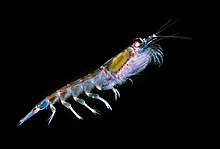Biomass (ecology)

In ecology, biomass refers to the cumulation of living matter. That is, it is the total living biological material in a given area or of a biological community or group. Biomass is measured by weight, or by dry weight, per given area (usually measured per square metre or square kilometre).
The most successful animal, in terms of biomass, is the Antarctic krill, Euphausia superba, with a biomass of probably over 500 million tons, roughly twice the total biomass of humans. The entire earth contains about 75 billion tons of biomass. Humans comprise about 250 million tons (0.33%), domesticated animals about 700 million (1.0%), and crops about 2 billion tons or 2.7% of the Earth's biomass.
Biomass may also be a measure of the dried organic mass of an ecosystem. As the trophic level increases, the biomass of each trophic level decreases. That is, producers (grass, trees, scrubs, etc.) have a much higher biomass than animals that consume them (deer, zebras, insects, etc.). The level with the least biomass is the highest predators in the food chain (foxes, eagles, etc.)
Biomass is also related to net primary productivity (NPP). Factors which limit NPP and thus mean biomass accumulates only slowly, include
- Low rainfall
- Low temperaures
- Little available nutrients
- Short growing season
- Lack of supply of stock material
Factors which encourage (NPP) and thus tend to increase biomass are the converse of these.
